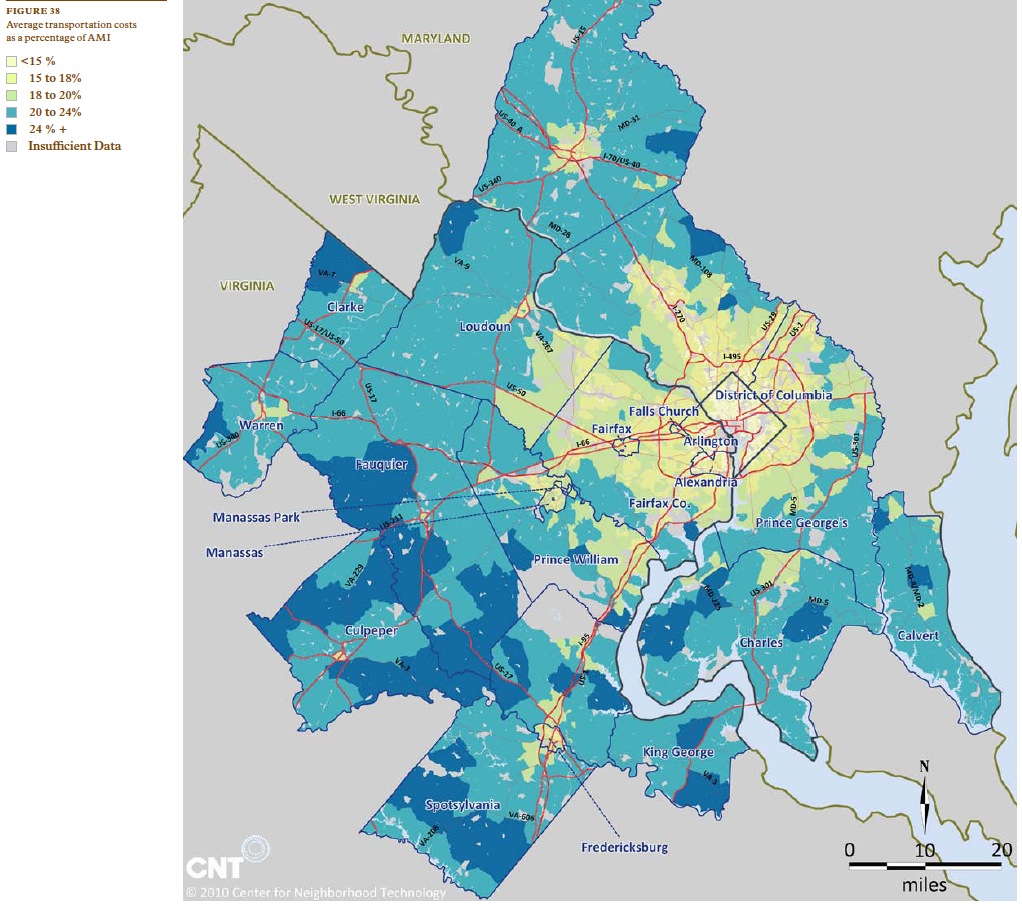THE CENTER FOR NEIGHBORHOOD TECHNOLOGY
Significance of Transportation Costs and the Lack of Transparency
Today, the real estate market knows how to incorporate the value of land into the price of the home—based on its location and proximity to jobs and amenities—but there is less clarity about how the accompanying transportation costs also contribute to the desirability of a location. In most cases, the very same features that make the land and home more attractive, and likely more expensive per square foot, also make the transportation costs lower. Being close to jobs and commuter transit options reduces the expenses associated with daily commuting. And being within walking distance of an urban or suburban downtown or neighborhood shopping district allows a family to replace some of their daily auto trips with more walking trips. Walking, bicycling, taking transit, or using car sharing instead of driving a private automobile reduces gasoline and auto maintenance costs, and may even allow a family to get by with one less automobile.
By contrast, places where single-family homes are more “affordable” are often found in outlying areas where land is cheaper. However, the lack of amenities and access to necessities common in these neighborhoods often results in households having transportation costs that are much higher and can often outweigh the savings on housing costs. In many of the areas where households “drive to qualify” for affordable housing, transportation costs can exceed 32% of household income, making it, at times, a greater burden than housing. Conversely, for some communities where households benefit from less automobile dependency, transportation can represent as little as 10% of household income.
This information gap on location efficiency, which is measured here as the cost of transportation associated with each place, leads to unexpected financial burdens and time constraints for households, poor location decisions by developers, and missed and misplaced opportunities for municipalities. Furthermore, it leads to misinformed criticisms of the cost of building transit, since these critiques do not fully account for the benefits or take into account the hidden costs associated with sprawl and auto dependency. Not only are the high costs of transportation hidden, but so are the low costs, and therefore so is the inherent value of more convenient in-town urban, inner-suburban, and other urbanizing locations. Consequently, many of these convenient but undervalued areas suffer from disinvestment and lack the ability to attract new investment and redevelopment.
Expanding the Definition of Affordability
From an affordability perspective, the lack of transparency in transportation costs puts households at significant financial risk. Traditionally, a home is deemed affordable if its costs consume no more than 30% of a household’s income. This measure, however, ignores transportation costs—typically a household’s second largest expenditure — which are largely a function of the area in which a household chooses to locate. This report proposes expanding the definition of housing affordability to include transportation costs to better reflect the true cost of households’ location choices. Based on data from 337 metro areas, ranging from large cities with extensive transit (such as the New York metro area) to small metro areas with extremely limited transit options (such as Fort Wayne, IN), CNT has found 15% of the Area Median Income (AMI) to be an attainable goal for transportation affordability. By combining this 15% level with the 30% housing affordability standard, this report recommends a new view of affordability, one defined as H+T costs consuming no more than 45% of household income.
Considering housing and transportation costs in conjunction changes the picture of affordability significantly. Many areas in which low home prices make the area appear affordable are no longer so attractive when transportation costs are added to the equation. Conversely, areas in which housing prices may seem out of reach for many households can actually become more affordable when high levels of location efficiency allow households to experience significantly lower transportation costs.
Download full version (PDF): Housing + Transportation Affordability in Washington, DC
About The Center for Neighborhood Technology
www.cnt.org
“Founded in 1978, the Center for Neighborhood Technology has been a leader in promoting more livable and sustainable urban communities. In fact, our work focused on sustainable development before the term became as popular as it is today. As a creative think-and-do-tank, we research, invent, and test urban strategies that use resources more efficiently and more equitably.”







 RSS Feed
RSS Feed